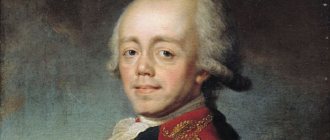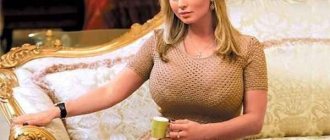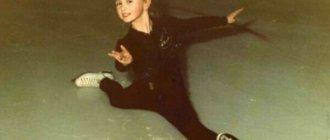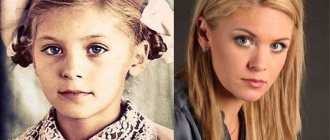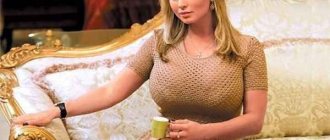Biography of Anna Pavlova
Anna Pavlova is the founder of Russian ballet, a dancer whom the whole world knew. She spoke the language of ballet. Anna Pavlovna could make even someone who did not understand and did not consider ballet an art fall in love with dance. Anna was not accepted into the school the first time: at eight years old, the girl was small and pale and looked too weak to study. Nyurochka was born prematurely (the midwife did not hope that the baby would survive), she was often sick in childhood, so for the summer the small family moved to St. Petersburg, to live with their grandmother. The latter taught the girl to read and write, handicrafts and generously treated her to simple village delicacies, hoping that the baby would get stronger faster with milk and sour cream. At this time she had a dream - to become a ballerina.
Biography
The great art of Russian ballet cannot be imagined without the legendary dancer Anna Pavlova. The prima of the Mariinsky Theater performed on the Russian stage for a decade, and then became a continuer of the traditions of the national school, which introduced the world to the works of the outstanding choreographer Mikhail Fokin.
Anna Pavlova
Throughout her life, Pavlova devoted more to dance than any of her contemporaries. The plastic monologue “The Dying Swan” became the ballerina’s calling card for many years and is still considered an unsurpassed and unique phenomenon of Russian stage art.
Childhood and youth, family
Anya saw the light in a village near the northern capital in February 1881. She spent her childhood in the capital, in a squalid wooden house, where she lived with her mother, Lyubov Fedorovna Pavlova, who did day labor, most often washing clothes. Little Nyura did not remember her father: she was told that he died when her daughter was not even two years old. According to his mother, Matvey Pavlov was a retired soldier; he gave the girl his last and patronymic names.
However, the true story of Anna’s origins remained unclear: later, when Pavlova had already become a famous artist, there were rumors that she owed her birth to a certain wealthy man in whose house her mother worked.
The name was mentioned of Lazar Polyakov, a Moscow banker. Later, the dancer’s biographers proposed another version: the girl was the daughter of a native of Yevpatoria, Shabetai Shamash, who lived in St. Petersburg under the Russian name Matvey and owned a laundry. One way or another, Pavlova never liked to remember this: in those days when she was a child, the stigma of “illegitimate” practically deprived a person of a future. Needless to say, neither she nor her mother sought to make the truth public. When her career took off, the ballerina completely changed her middle name (for the sake of stage euphony, of course!), becoming Anna Pavlovna.
The riddle remained a riddle, and a simple washerwoman grew up with a black-eyed and graceful daughter, displaying obvious musicality and sensitivity to the arts. According to the documents, the child was considered completely “legitimate” (perhaps the real father helped with this); The Pavlovs lived through the labors of Lyubov Fedorovna. Mother still worked “for people”, in addition, she completed sewing courses and sewed to order. The clientele was not rich, and it was difficult to make ends meet.
Anna Pavlova wrote later: “My first memory is a small house in St. Petersburg, where my mother and I lived alone... We were poor, very poor.”
Anna’s childhood cannot be called rich in impressions: walks in the vicinity of Ligov to the sound of pine trees and the splash of a small river, grandmother’s garden, winter slides. However, Anna’s caring mother still managed to find funds for little children’s joys. Memories of this invariably awakened a feeling of gratitude in my daughter. “When I was eight years old, my mother announced to me that we would go to the Mariinsky Theater”
The theater made an indelible impression on Anna. The whole trip was accompanied by a feeling of celebration: the journey in a cab, the solemn colonnade of a building that looked like a fairy-tale palace, brightly lit staircases, a hall full of elegant people - everything delighted eight-year-old Nyurochka, who was not spoiled by entertainment. However, the biggest shock was the ballet itself. That day they showed “Sleeping Beauty”.
Later, in her biographical notes, Pavlova wrote about this moment, which turned her whole life upside down: “A few more minutes - and an unknown world opened up before me. From the very first notes of the orchestra, I trembled all over... The curtain rose, revealing the gilded hall of the palace, I quietly screamed with joy...”
From that day on, Anna literally dreamed of ballet and begged her mother to take her to the entrance exams of the ballet department at the theater school. To the surprise of the future dancer, the examiners were interested not so much in her knowledge as in her physical form. The requirements turned out to be harsh; It is no coincidence that Pavlova was not accepted into the school right away. Applicants who were stooped, short-sighted or weak-hearted were eliminated.
After completing all the exams (which included not only tests in writing, reading and arithmetic, but also a thorough test of musical ear), out of sixty girls, only eleven were accepted into the school, and Pavlova was among them! “I was crazy with delight when the director promised to enroll me as a student,” she recalled as an adult.
Anna now returned home only for the holidays, where, despite the joy of meeting her mother, to whom she always felt tender affection, she missed school. Only there did she feel that she was living life to the fullest; everything there made her happy: school, music and the true magic called creativity. Her comrades on the theater stage were waiting there - after all, many of those who were destined to glorify Russian ballet studied at the same time as the future ballerina.
Childhood turning into adolescence
The eighth, youngest child in the family of X-ray technician Vasily Petrovich and kindergarten teacher Maria Ilyinichna Pavlov from Cheboksary was born on May 15, 1956. The daughter was named with the telling name Nadezhda. The parents did not yet know that their Nadezhda would become a rising hope, and then a shining star of Russian ballet. At the age of 7 she went to the House of Pioneers and joined a dance club.
A little later, mom and dad noticed that their daughter had lost a lot of weight. They got worried and took her to the doctor. Then everything became clear: she went on a diet. The girl’s parents began to control the girl’s nutrition. When Nadya was ten years old, a commission from Perm came in search of talented children. She was immediately invited to study at the Perm Choreographic School. During the exams, Nadezhda Pavlova amazed everyone with her natural professional qualities. Classes have started. In the second grade, Nadya got a strict teacher, Lyudmila Pavlovna Sakharova. She introduced new trends of the times into classical classes - sports and theatrical dance. Everything was worked out down to the very last detail. All movements must be perfect: strong finger technique, confident rotation, aplomb and even acrobatics. Long trainings, complete submission to a passionate teacher, in addition to high technology, also turned out to be another side - mental instability. Already from the second grade, Nadezhda Pavlova has been performing at concerts with numbers that were staged especially for her: “Girl and Echo”, “Naughty Girl”, “Little Ballerina” and, of course, participates in all children’s parts of the Perm Theater: Doll in “Coppelia”, Cupid in Don Quixote and Little Red Riding Hood in Sleeping Beauty. At the age of 14, not even a graduate yet, she was noticed by critics on tour in Moscow, noting, along with the technique, the adult inner content of her performance. Without graduating from college in 1973, Nadezhda Pavlova received the Grand Prix of the II International Ballet Competition.
In parentheses, we will say that after this only three dancers received the Grand Prix. While preparing for it, she meets Vyacheslav Gordeev, who has been working at the Bolshoi Theater since 1968.
Ballet career
Beauty, simplicity and grace - this is what Petipa sought in his productions, which were strikingly different from European choreographic experiments in which technique dominated over content.
It was this principle that formed the basis of the Russian ballet school, glorified by such outstanding artists as Pavlova. Successful completion of college increased the graduates' chances for a successful career. Pavlova was lucky: she and her classmates received the right to make an open debut on the stage of the Mariinsky Theater. Pavlova's debut performances were very successful - her dance was appreciated not only by her mentors, but also by the audience. A start had been made: the promising dancer was immediately enrolled as a luminary, considering the graduate’s talent too bright for the corps de ballet. On the stage of the Mariinsky Theater, Anna had to master the achievements of the classical repertoire and create her own, reflecting not only her creative individuality, but also the elusive, exciting spirit of the new era. The technical part of the dance turned out to be the most difficult for Pavlova; the debutante coped with the artistic part much easier. While rehearsing the fairy Lily of the Valley in the ballet “The Sleeping Beauty,” Anna had her feet bleeding, practicing the elements invented by Petipa, but she was not going to give up. Roles in The Awakening of Flora, Paquita, and The Magic Flute gave the aspiring ballerina the necessary experience in mastering classical choreography.
Thanks to the support of her old teacher Evgenia Pavlovna Sokolova, who worked at the Mariinsky, Anna began preparing solo parts in the ballets “La Bayadère”, “Giselle”, “Naiad and the Fisherman”. Participation in these performances was highly appreciated by both the audience and the theater management: already in 1903, the ballerina received the position of “first soloist” with a salary of 1,800 rubles per year.
In 1905, Pavlova received the title of ballerina - she could rightfully be proud of herself. A very young dancer, the girl was at the peak of her creative and physical powers and was ready for new achievements. There was only one thing left to do: it was necessary to find suitable choreographic material that fully corresponded to the capabilities and talents of the rising star.
The muse of dance Terpsichore again showed favor to Pavlova: fate brought her together with Mikhail Fokin, who was to become one of the most outstanding choreographers of the early 20th century. In fact, they had known each other for a long time - they studied together (Misha was older), performed on the same stage and were partners in many ballets. Fokine's choreographic ideas were seriously different from the classical style adopted in the academic theater; his productions had many critics, but in his creative style there was something felt that was absolutely in tune with Pavlova's talent.
Anna Pavlova's first foreign tour took place in the summer of 1907, it was a tour of Northern Europe. The small troupe presented a small program - a choreographic divertissement, consisting of separate numbers. The recognition of the European public, who highly valued the classics, deeply touched the young performer.
From now on, Pavlova saw a special mission in her work - to introduce foreign ballet fans to Russian achievements. It so happened that the ballerina’s participation in the famous “Russian Seasons” became a rather insignificant episode in her career. Meanwhile, this grandiose project, organized by Sergei Diaghilev, had a wide resonance in European cultural life.
After her first foreign tour and participation in the Russian Seasons, Pavlova found herself in great demand abroad: the growing popularity of Russian ballet contributed to the conclusion of new contracts. The audience of admirers of the ballerina expanded every year, tours in the USA and Great Britain played a significant role in this. The audience at the Metropolitan Opera in New York and London's Palace Theater applauded Anna Pavlovna's performances with equal enthusiasm.
Contemporaries left quite a lot of evidence about the famous ballerina: Anna was so famous and revered during her lifetime that her biographers have very rich material. According to most colleagues in the artistic workshop, fate generously gifted Pavlova - from birth she was lucky enough to become the owner of unique qualities that formed the foundation of her skill.
Pavlova was already noticed at student performances, and the ballerina’s new roles never went unnoticed by critics. At first, the ballerina was seen only as a talented continuer of the classical tradition. After the premiere of Chopiniana, Anna seemed to have her reputation as an academic dancer forever established.
By the time it became clear not only to Russian but also to foreign reporters that “Pavlova is not an artist, but a phenomenon,” many critics tried to figure out the formula for her artistic talent. Often words were powerless here. It was her stage colleagues who left the most detailed reviews of her work. Taking into account the competition and difficult atmosphere of the artistic world, you can trust their objectivity, given that the opinions of a variety of people are almost unanimous.
Pavlova’s style was so individual that it is impossible to confuse her with any of her contemporaries, just as it is impossible to teach one of them to dance “Pavlovian style.” As for the personal qualities of Anna Pavlovna, a very contradictory picture emerges from the evidence of her contemporaries. To outsiders, she gave the impression of a withdrawn and self-absorbed person, as if living according to her own internal clock. From her youth she loved music and reading - these activities nourished her spirit and gave birth to artistic associations that were so necessary in her work.
In her house, Pavlova received guests, gave lessons and rehearsed. Few managed to adapt to her work style. Natalya Trukhanova, a friend of Anna’s, who observed her usual daily exercises, could not hide her surprise: Pavlova performed the usual set of exercises three times faster than any of the famous dancers, but at the end of the program she literally fell into a chair in exhaustion. It was her own rhythm - the ballerina was famous for her ability to quickly master choreographic material.
The speed with which Anna perceived the impressions of the world around her required constant renewal of life. Traveling around the Old and New Worlds added dynamism and festivity to existence: the ballerina met new admirers of her talent, admired unprecedented landscapes, and became acquainted with other cultures.
It was no coincidence that the sharp-tongued press dubbed the dancer “Terpsichore of packet boats,” hinting at her endless travels across the seas and oceans. It seemed that there was not a single corner of the world left on the map where the famous ballerina had performed. Over twenty-two years of touring, Anna Pavlovna performed more than nine thousand performances in forty-four countries. USA, Canada, Mexico, Japan, Philippines, India, Egypt, South Africa, Australia, New Zealand - thanks to Pavlova, audiences around the world became acquainted with the traditions of Russian classical ballet.
Enchanting career
History wanted them to meet - two geniuses - Pavlova and Fokin. Ballerina and choreographer. He directed “The Swan” by Saint-Saëns for her, then Nikia in “La Bayadère”, “Chopinian” and many other roles. Pavlova's ascent to the artistic Olympus was akin to a bright comet, burning everything in its path. In 1907, Anna tasted the sweetness of triumph in Scandinavia, receiving the Order of Merit for Art from the hands of King Oscar II. People were so shocked by her performances that they remained reverently silent as they accompanied the ballerina to the hotel, and then gave her a standing ovation when she appeared on the balcony.
| Anna Pavlova in the ballet La Sylphide | Anna Pavlova in the ballet "Raymonda" | Anna Pavlova in the ballet "Bacchanalia" New York 1923 |
Paris bowed to the prima after seeing her in Diaghilev's seasons. There were other victories. Anna Pavlova toured more and more with the theater troupe. The work brought her happiness and peace, and the image of Victor Dandre, who had inflicted a cruel insult, gradually faded. The woman is a legend. Woman-myth. Legends don't cry and don't fall in love.
And suddenly the series of successes came to an abrupt end. Newspapers published more and more details of the scandal that broke out. The ballerina leaves Diaghilev. He showers her with curses. Pavlova enters into a dubious contract with the director of an English variety show. What a passage! For a whole year she will dance for a chewing public, in between the cancan and the clowns. Yes, positively the prima has gone crazy.
Personal life
Anna Pavlova is the founder of Russian ballet, a dancer whom the whole world knew.
She spoke the language of ballet. Anna Pavlovna could make even someone who did not understand and did not consider ballet an art fall in love with dance. To outsiders, especially if it did not happen on stage, Anna Pavlova sometimes gave the impression of a withdrawn and unfriendly person, but upon closer acquaintance, both her emotionality and temperament were revealed. One of the happy qualities of the ballerina’s character was the ability to quickly switch: she did not harbor grudges, quickly forgot conflicts and did not lose the ability to enjoy life. All this made her a charming woman. In addition, the dancer had a spectacular appearance. Baron Victor Dandre knew Pavlova for many years. A friend of Marius Petipa, he had a reputation as an admirer of the arts and a regular at theater boxes. The long-term courtship of a delicate admirer (who was ten years older than her) eventually had an effect: Anna reciprocated Dandre’s love. For his girlfriend, the baron rented a luxurious apartment on Ofitserskaya Street (with its own rehearsal hall), where he became a frequent guest. Those around him were accustomed to seeing him next to Anna, but, of course, there could be no talk of legitimizing their relationship: the heir of an aristocratic family was not supposed to marry an artist and the daughter of a washerwoman.
However, he no longer had a family fortune for a long time: Mr. Dandre received a salary in the civil service, performing the duties of a Senate prosecutor and chairman of the Duma Audit Commission. In 1912, a trial was launched against him - Dandre was accused of abuses and bribes, as well as theft from the city treasury. When the court ordered the accused to pay a fine of 36 thousand rubles, the amount was found quite quickly. There is a version that it was collected by Anna, who by that time was actively touring abroad. Dandre himself quickly left the country using forged documents.
From now on, he became an indispensable impresario for Pavlova, or, as the British said, a manager: the baron took upon himself the hassle of organizing her tour. Contacts with the receiving parties (among the representatives of the latter were Max Rabinov, Daniel Meyer and the famous Solomon Yurok), repertoire policy (the troupe’s choreographer-director was I.N. Khlyustin), contracts with new artists - in all these activities Dandre discovered the remarkable talent of an entrepreneur.
In fact, they changed roles: now it was not Anna who depended on him, but Dandre’s own well-being turned out to be connected with her career. Considering the difficult nature of both, their relationship with the ballerina resembled the life of spouses with great experience: there were enough quarrels and reconciliations, as well as irritation, tenderness and mutual care. The only question that biographers doubt is whether they were married? Some sources claim that the couple got married in Russia, others - that the marriage took place in Europe. In the first case, the situation compromised the baron, in the second, it interfered with Anna’s image.
One way or another, it is quite clear that this ceremony, if it really took place, was a secret to everyone around. Ultimately, this ambiguity played a cruel joke on Dandre: after the death of his wife, he could not inherit either her house or money. The only thing left for him is the archives, which allowed him to write a book about his mysterious companion.
Touring and statistics
Anna Pavlova led an active touring life for 22 years. During this period, she took part in nine thousand performances, two thirds of which were performed in the main roles. Moving from city to city, the ballerina traveled at least 500 thousand kilometers by train. An Italian ballet shoe maker sewed two thousand pairs of pointe shoes a year for Anna Pavlova.
In between tours, the ballerina rested with her husband in her house, among tame swans, in the shade of trees, near a still clean pond. On one of these visits, Dandre invited the famous photographer Lafayette, and he took a series of photographs of Anna Pavlova with her favorite swan. Today these photographs are perceived as a memory of the great ballerina of the 20th century.
In Australia, in honor of the Russian ballerina Anna Pavlova, they came up with the Pavlova dessert made from exotic fruits with the addition of meringue. By the way, New Zealanders claim that they created the fruit treat.
Once Anna Pavlova danced on the theater stage the popular Mexican folk dance “jarabe tapatio”, which means “dance with a hat”, in her interpretation. Enthusiastic Mexicans threw hats at the ballerina and the entire stage. And in 1924, this dance was declared the national dance of the Mexican Republic.
In China, Anna Pavlova surprised the audience by dancing 37 fouettés non-stop on a small platform mounted on the back of an elephant walking across the field.
Dutch flower growers grew a special variety of snow-white tulips, which received the name of the great ballerina Anna Pavlova. Graceful flowers on thin stems symbolize grace.
Several different monuments dedicated to the ballerina were erected in London. Each of them relates to a certain period of her life. Three monuments are erected near the Ivy House, where Pavlova lived most of her life.
Anna was distinguished by a rare love of humanity, she was involved in charity work, and opened several orphanages and shelters for homeless children. Girls and boys from the guests of these institutions who had the ability to dance were selected and sent to the school of children's choreography, opened in the Ivy House.
A separate act of Anna Pavlova’s charity was her assistance to the starving people of the Volga region. In addition, on her behalf, parcels were regularly sent to the St. Petersburg Ballet School.
Last years and death
Having become the head of her own troupe, Pavlova was aware of her responsibility for the rest of the dancers.
This group was truly international: it consisted of people from Russia, Poland and Western Europe (many later made solo careers). The affairs of the concert enterprise were kept in almost perfect order: the artists were regularly paid their salaries, were entitled to insurance and bonuses. In January 1931, the train on which Pavlova and her artists were traveling collided with a freight train. The incident did not have any serious consequences, however, while walking to the nearest station, the artist caught a cold. They also said that a heavy trunk fell from the top shelf, hitting Anna painfully in the ribs. Accustomed to pain thanks to her profession, the ballerina soon forgot about what happened and remembered about the injury only during a tour in the Netherlands, surprised that the cold she caught along the way did not go away.
When she became worse, a council of doctors meeting in The Hague noted the development of pleurisy. Doctors suggested surgery, but did not guarantee that after it the dancer would return to the stage. Pavlova refused. On the night of January 22-23, the ballerina died. Thus, the cause of death of the great ballerina was severe pleurisy.
Legend has it that in her last moments she was worried about the upcoming tour, and finally asked: “Bring me a swan costume...”.
The Pavlovsk troupe still went on tour. It was a kind of memorial tour: Anna’s favorite numbers were danced by her colleagues. And only during the performance of “The Dying Swan” was the stage empty: the pattern of Pavlova’s movement was drawn across it with a spotlight.
Further creativity
Pavlova Anna Pavlovna, an active nature, had plans for her creative development. Her husband, fortunately, suddenly discovered an ability to produce and began promoting his wife’s career. He became the official impresario of Anna Pavlova, and the great ballerina no longer had to worry about her future; it was in good hands.
In 1913 and 1914, the dancer performed in Moscow and St. Petersburg, including the Mariinsky Theater, where she danced the role of Nikiya for the last time. In Moscow, Anna Pavlova appeared on the stage of the Mirror Theater in the Hermitage Garden. After this performance, she went on a long tour of Europe. This was followed by months of tours in the USA, Brazil, Chile and Argentina. Then, after a short break, Dandre organized a tour of Australia and Asian countries.

